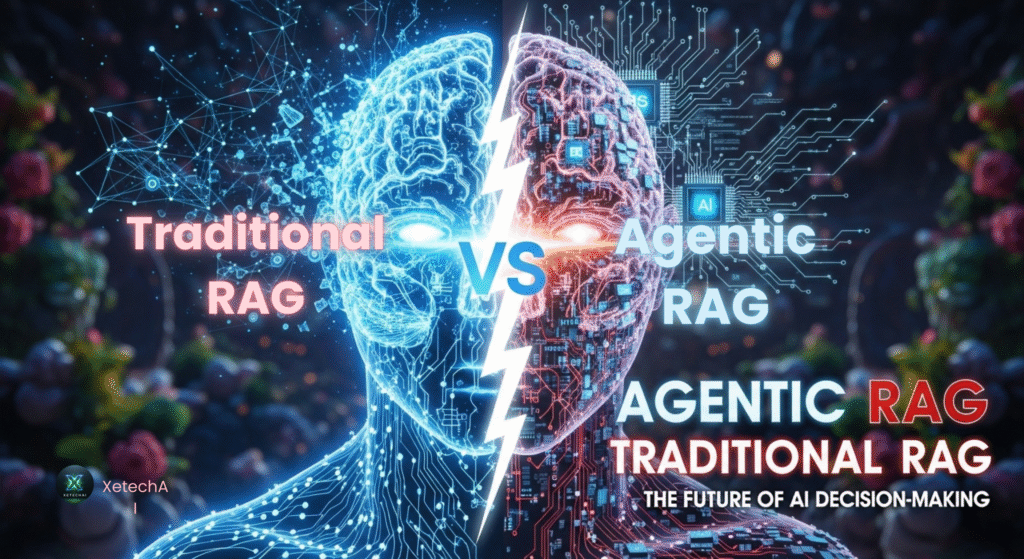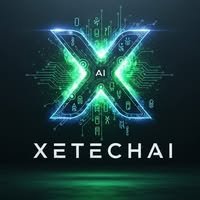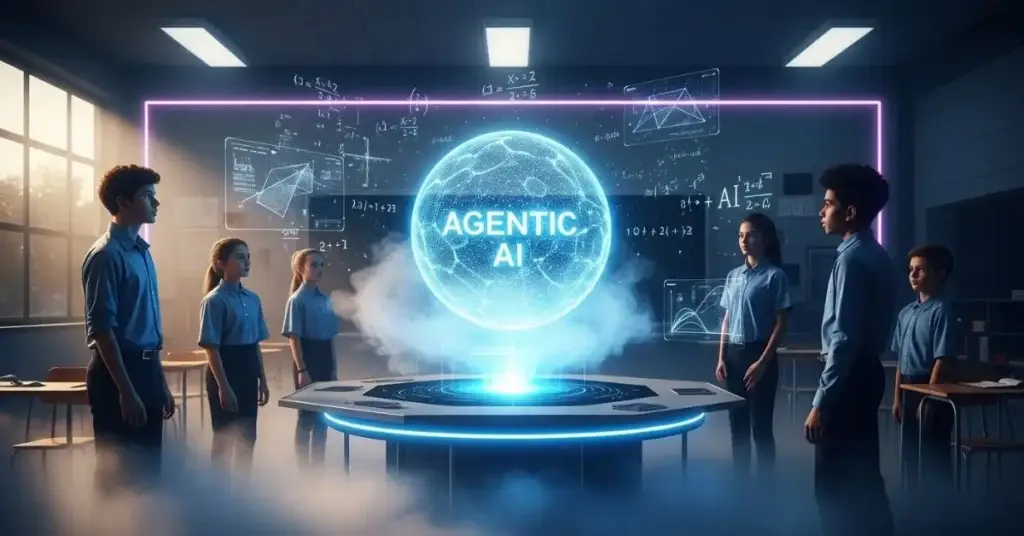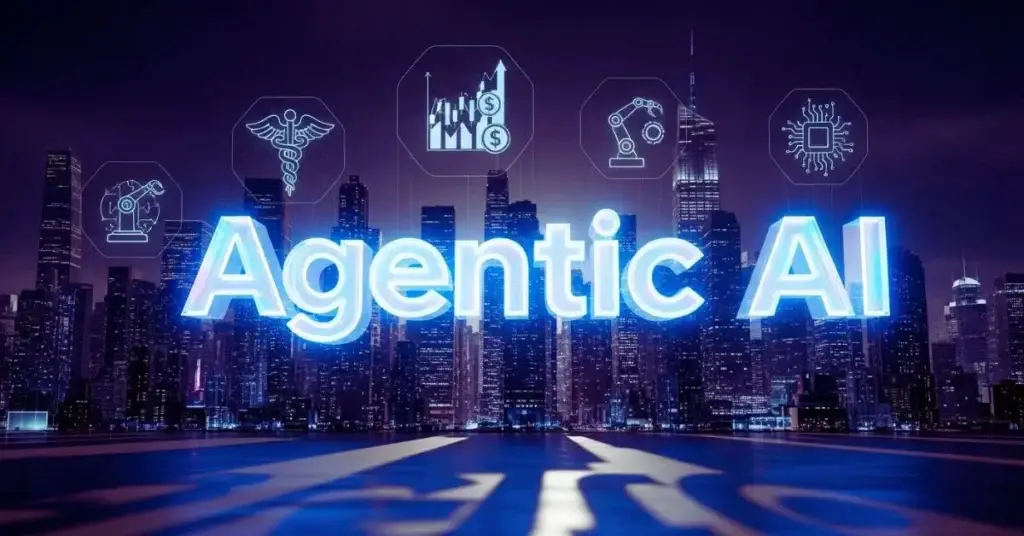
Introduction: The New Era of AI Knowledge Systems
AI is no longer just about chatbots giving quick answers. In 2025, enterprises in the USA and Canada are moving beyond static systems toward Agentic AI intelligent agents that don’t just retrieve information but also reason, plan, and act.
At the center of this transformation is a significant shift from Traditional RAG (Retrieval-Augmented Generation) to the more advanced Agentic RAG. If you’re a business leader, CIO, or tech enthusiast, understanding this shift could define whether your company thrives or struggles in the new AI economy.
What is Traditional RAG?
Traditional RAG has been the backbone of enterprise AI search since 2020. The concept is simple:
- A user asks a question.
- The system retrieves documents from a knowledge base.
- A large language model (LLM) uses this retrieved context to generate an answer.
This workflow is linear and one-shot, fast and effective for FAQs, knowledge bases, and simple enterprise chatbots.
Limitations of Traditional RAG:
- Static Retrieval: It pulls documents only once, often missing context.
- Lacks Reasoning: No ability to refine queries or correct itself.
- Compliance Gaps: For regulated industries in the USA/Canada (finance, healthcare, government), one-shot retrieval can lead to errors or privacy concerns.
Enter Agentic RAG: A Smarter Approach
Agentic RAG takes the same concept but makes it dynamic and autonomous. Instead of stopping after one retrieval, it works like an intelligent assistant that can plan, iterate, refine, and integrate multiple tools.
Key Features of Agentic RAG:
- Iterative Retrieval: Keeps refining until the most relevant data is found.
- Tool Use: Can call APIs, run database queries, or check compliance logs automatically.
- Multi-Agent Collaboration: Specialized agents (retrieval, summarization, reasoning) work together.
- Human-in-the-Loop (HITL): Enterprises can add approval checkpoints before critical decisions.
Think of Traditional RAG as a search engine, while Agentic RAG is more like a team of AI researchers working together in real time.
Why USA and Canada Enterprises Care in 2025
Compliance, security, and ROI are top priorities for businesses in the USA and Canada. Here’s why Agentic RAG is quickly replacing older models:
- Healthcare Compliance (HIPAA, PIPEDA):
- Hospitals in Canada and the USA need systems that retrieve information and check compliance before surfacing results. Agentic RAG ensures that patient-sensitive data is handled responsibly.
- Financial Services (SOX, SEC Regulations):
- Banks can’t risk incorrect answers in audits. Agentic RAG can double-check sources, flag risks, and provide explainable results.
- Government Services:
- Public sector agencies need audit trails. Agentic RAG’s iterative process logs every step, ensuring transparency.
- Enterprise ROI:
- In Canada’s retail and the USA’s logistics industries, companies report that Agentic RAG reduces response times and boosts productivity compared to static RAG systems.
Real-World Examples
- Amazon Q Business (USA): Amazon’s new Agentic RAG system dynamically adjusts responses and uses multi-turn reasoning to improve enterprise search.
- Microsoft & MCP (Canada/USA): Microsoft supports the Model Context Protocol (MCP), allowing multiple AI agents to collaborate securely.
- Freshworks (Canada/Global): CRM platforms now use Agentic RAG to handle customer support autonomously.
Advantages of Agentic RAG Over Traditional RAG
| Feature | Traditional RAG | Agentic RAG (2025) |
|---|---|---|
| Retrieval | One-shot, static | Iterative, adaptive |
| Reasoning | None | Multi-step planning & self-correction |
| Tool Use | Limited | APIs, databases, compliance checks |
| Enterprise Fit (USA/CA) | Basic knowledge bases | Finance, healthcare, gov-ready |
| Compliance Support | Weak | Strong with audit trails |
| ROI Impact | Moderate | High (scalable + efficient) |

Challenges of Agentic RAG
Of course, Agentic RAG isn’t perfect. Enterprises must prepare for:
- Higher Complexity: Needs orchestration frameworks like LangGraph or CrewAI.
- Latency & Cost: More iterations = more compute resources.
- Agent Reliability: Wrong tool use or over-retrieval risks must be managed with observability.
However, these risks can be minimized with proper governance and human-in-the-loop (HITL) safety checks.
How to Get Started with Agentic RAG in the USA & Canada
If you’re running a business in the USA or Canada, here’s how you can prepare:
- Pilot Small: Start with one workflow (like compliance checks or customer support).
- Use Secure Frameworks: Adopt trusted orchestration tools (LangGraph, AWS Bedrock AgentCore).
- Add Guardrails: Build observability and audit systems.
- Train Your Teams: AI adoption is not just technical but cultural.
Future Outlook (2025–2026)
Analysts predict that by 2026, 60% of enterprise AI deployments in North America will involve agentic systems. The combination of RAG + autonomy + compliance is becoming a gold standard.
For USA and Canada enterprises, moving to Agentic RAG is less about being “cutting-edge” and more about staying competitive and compliant.
Conclusion
Traditional RAG laid the foundation for enterprise AI, but in 2025, it is no longer enough. USA and Canada enterprises now demand systems that think, adapt, and act responsibly. Agentic RAG delivers more intelligent retrieval, compliance-first operations, and scalable ROI.
If you’re a CIO, founder, or developer, now is the time to experiment with Agentic RAG. The companies that adopt it today will be tomorrow’s AI leaders.
If you’re interested in exploring more about the rise of Agentic AI and why it’s becoming the foundation of the next AI revolution, don’t miss our detailed guide: Why Agentic AI is the Next Big Leap in the AI Revolution?
FAQs on Agentic RAG vs Traditional RAG (2025)
Q1. What is the main difference between Agentic RAG and Traditional RAG?
Answer: Traditional RAG retrieves and generates answers from a knowledge base. In contrast, Agentic RAG works with multiple intelligent agents that can analyze, plan, and collaborate. This makes it far more effective for enterprises in the USA and Canada looking to scale AI in 2025.
Q2. Why are enterprises in the USA and Canada moving toward Agentic RAG in 2025?
Answer: Because businesses need more intelligent AI. Agentic RAG allows agents to use tools, verify information, and make decisions something Traditional RAG cannot do. This shift helps companies in the USA and Canada achieve better automation and efficiency.
Q3. Is Agentic RAG more expensive than Traditional RAG?
Answer: Not necessarily. While the initial setup may require more resources, Agentic RAG reduces long-term costs by improving accuracy, lowering human intervention, and automating complex workflows for North American enterprises.
Q4. Can small businesses in the USA and Canada also adopt Agentic RAG?
Answer: Yes! While large enterprises are the early adopters, small and medium businesses in the USA and Canada can also benefit from Agentic RAG to improve customer support, content creation, and research automation.
Q5. How is Agentic RAG shaping the future of AI in 2025?
Answer: In 2025, Agentic RAG redefines AI by combining knowledge retrieval with multi-agent intelligence. It sets a new standard in AI adoption for the USA and Canada, making businesses more competitive and innovative than those relying only on Traditional RAG.
Q6. Does Agentic RAG improve accuracy compared to Traditional RAG?
Answer: Yes. Agentic RAG uses multi-agent collaboration to cross-check and verify answers before presenting them. This makes it much more accurate than Traditional RAG, especially for enterprises in the USA and Canada dealing with sensitive data in 2025.
Q7. Which industries in the USA and Canada will benefit most from Agentic RAG?
Answer: Industries like finance, healthcare, education, and e-commerce are leading the adoption of Agentic RAG in 2025. These sectors need smarter AI for compliance, data processing, and customer engagement, where Agentic RAG outperforms Traditional RAG.
Q8. What challenges might businesses face when shifting from Traditional RAG to Agentic RAG?
Answer: The main challenges include integration, training staff, and higher initial setup. However, once deployed, Agentic RAG delivers long-term benefits such as efficiency, cost savings, and scalability for USA and Canadian companies compared to outdated Traditional RAG systems.


